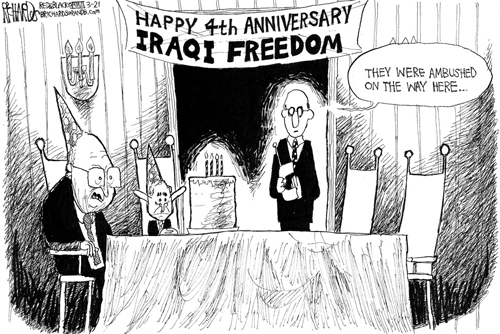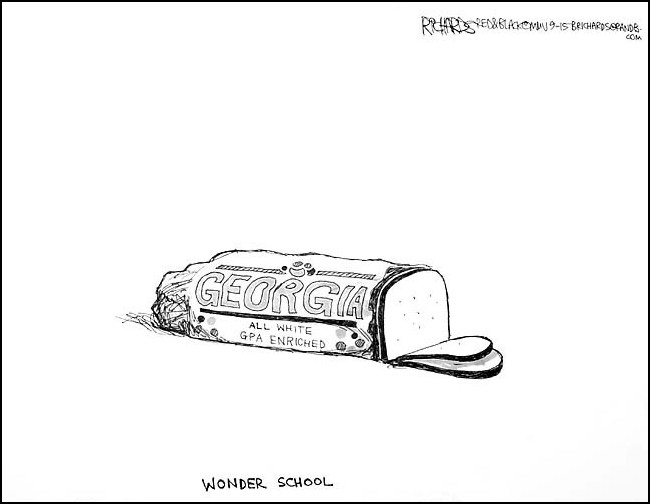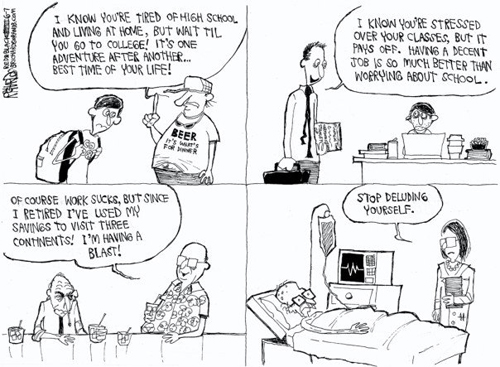Back in October, I kicked off these young cartoonist profiles with the Daily Nebraskan’s Bob Al-Greene. Now the series continues with Bill Richards, recently-retired cartoonist from The Red and Black, the student newspaper at The University of Georgia at Athens.
Richards has received plenty of recognition, including receiving the Society of Professional Journalists’ “Mark of Excellence” award in 2006 and 2007 and being named a finalist for the 2007 Scripps-Howard National Journalism Award. Last month, he was awarded first place in editorial cartooning at the Society of Professional Journalists regional awards and was one of two finalists for the Charles M. Schulz award.
Readers of this site may remember him as one of the collected Virginia Tech cartoonists; I first heard of Richards when someone told me Michael Ramirez had ripped off a college cartoonist from Georgia. Ramirez just won the Pulitzer, so it’s good company.
Since drawing his last cartoon for the Red and Black in January, Richards has been keeping billrichards.wordpress.com updated with more cartoons, commentary and some animations. His absence has been felt on campus, as a Facebook group called “We Miss Bill Richards” has gone up in his honor.
NEAL OBERMEYER: When did you get your start in editorial cartooning, and what made you decide to start?
BILL RICHARDS: The first editorial cartoon I ever drew was in sixth grade. I think I just drew the school principal making fun of a student who was being crushed by his heavy bookbag. I mostly drew comic strips until college, but I slowly started incorporating more and more overt commentary as I got older. And once I got to college they wouldn’t let me draw comic strips for the paper, so I started “seriously” doing editorial cartoons. At least, I think that’s how it went.
But it was always mainly about the groupies.
N: Did The Red & Black have a cartoonist before you, or were you filling a new role at the paper?
B: They always had cartoons in the paper — Jack Davis of MAD fame drew for The Red & Black in the late 40s when he went to UGA. And there was a guy a few years before me who was pretty good, Mack Williams, who is now the head animator for one of the Adult Swim animation houses. But I didn’t start seriously doing editorial cartoons until I got to Georgia, save for one or two I did my senior year of high school. I just had always been more comfortable with the multi-panel comic strip format. But that’s changed a bit now.
N: How many times a week did your cartoons run in the paper?
B: Freshman year I started out doing one a week. Then it was two a week. Then it was two or three a week. And by the end of spring 2005 I was doing most of them. Starting fall 2005 I was doing all of them and held the official “editorial cartoonist” title in the staff box. And save for a semester studying abroad, I held down that schedule until this past January.
N: How much do you read editorial cartoons and how much have you read them in the past?
B: When I was a kid my parents had news magazine subscriptions, so I’d read the weekly roundups. Of course the national publications always get rid of the cartoonist’s signature, so I never really knew who any of them were until I was in high school and college. Except for Tom Toles, who was in The New Republic every week. And Mike Luckovich, my hometown guy.
Once I started doing cartoons full-time I realized I should probably know the types of cartoons other people were doing, so I started reading Cagle’s site. And whenever other cartoonists would come up with the same idea as me, I would think “wow, I’m doing this right.” But now I realize that most cartoons are actually pretty bad. But I’ve still got a few that I read regularly.
N: Can you elaborate on what you feel makes most cartoons pretty bad?
B: I guess they really aren’t bad. They’re just boring. I can see what story is making the headlines and easily predict the direction that a large percentage of cartoonists will take. Like you and The Bad Cartoonist have written, editorial cartoonists have this sense of righteous indignation about the fact that they’re getting laid off, but when you read Cagle, most of the output is predictable.
But if you want a better idea of what I’m talking about, read the Kelly cartoons in The Onion. It’s brilliant — the phony sentimentality, the little wisecracking guy in the corner, the labels, the crying Statue of Liberty — all the standard tropes are there.
So it’s not a “condemnatory” boring, it’s a “we could be doing so much better” boring.
N: How does that affect your attitude toward your work? Is it motivational, like “I can be better than most of the cartoonists out there,” or is it discouraging, like “Obviously the masses like stuff that stinks. What am I doing in this business?”
Well, obviously the masses have very little to do with what goes into corporate media outlets. Back in the late 19th century, newspaper moguls knew that the public liked big pretty pictures. So newspaper comics were born. The public clearly likes pictures more than words — I think that’s pretty self-evident.
But I think that in order to understand the demise of editorial cartoons, we have to view the corporate media model through the lens of rationalization. A business like Tribune Co. that exists to turn a profit wants a reliable stream of advertising revenue, which it can get by avoiding controversy and being safely predictable. But editorial cartoons aren’t predictable (in theory.) They’re a very obvious lurking variable that serves to ebb the tendency of corporate media toward rationalization and standardization. Which is why The New York Times doesn’t hire an editorial cartoonist. Instead, they hire Bill Kristol. And why shouldn’t they? Cartoonists use images and metaphors that make people mad in lots of unpredictable ways, and that tendency runs contrary to any rational, corporate business model.
In sum, I don’t want to say that I’m doing something that’s better than what everyone else is doing. That’s not for me to decide. But I try to present something that’s different from the other stuff that’s out there. I try to give the reader a broader perspective on a given issue than “Democrats and Republicans are fighting again.” Is it a happy, comic perspective? No. But it’s not something you see in mainstream cartoons. Except when it is, and when I don’t.
N: Who are your biggest influences?
B: In no particular order: Luckovich, Mike Ramirez, Scott Stantis, Bill Watterson, Robert Crumb, Berkeley Breathed, Matt Davies, Garry Trudeau, Steve Benson, Rob Rogers, Tim Menees, Ralph Steadman. So there are a lot of them.
N: What is your process like? As far as developing your ideas, getting approval, execution, and so on? How has that changed through your career? Are there ways in which coming up with ideas has gotten easier or harder over the several years of experience?
B: I used to take much, much longer than I do now. But when I first started I was going toward “This Modern World”-type polemics, which take longer to write because they are overly wordy and preachy. Now I am much quicker. But every morning invariably starts with me drinking coffee and reading The Red & Black and The Atlanta Journal-Constitution every morning, plus a handful of political blogs.
Then I figure out if there’s anything worth drawing about related to Athens or UGA. If there’s not, then I move to state, then national.
Once a story jumps out at me, I stare at a piece of paper and think. This can go on for ten minutes or two hours. It depends on the week. I have good weeks and bad weeks. I’m a very streaky cartoonist. I’m not sure if anyone else is this way.
On very rare occasions I will be visited by scantily-clad angels who give me a brilliant idea that I then must immediately commit to whatever writing surface is in front of me. On ever rarer occasions a friend, coworker or classmate will give me a good idea. I can count on one hand the number of times this happened while I was at the R&B.
Excluding freshman year, when the editors didn’t really trust me, getting cartoons approved was amazingly easy. Sophomore year, when I started doing cartoons full-time, I had a great editor who would give me lots of constructive criticism, which was immensely valuable. But after that, I realized that my editors would generally just take what I gave them. And the past two summers, I was my own editor. It was pretty much the ideal situation as far as creative control goes. But was it good for my teamwork skills? Probably not.
N: What kind of response have you gotten from your work? How was it received on campus? Outside campus?
B: It’s sad, I rarely get hatemail. But when I do, it’s when I least expect it. For instance, take the VT/smoking gun logo everyone drew last year after the Virginia Tech shootings. Well, I did one of those and got about two hundred online comments from people telling me to burn in hell. Completely unexpected. The best part was when my girlfriend and I were in Starbucks and the baristas were talking about that insensitive Red & Black cartoon, not knowing the culprit was standing right in front of them. It’s funny, the only thing I regret is drawing such a crappy cartoon.
But most people really don’t care that much, unless they know me, in which case they feel obligated to read and react. And the Athens townies don’t really read The Red & Black, so I don’t get much off-campus exposure. But what little I’ve gotten has been fairly positive, if only because those readers are more self-selecting.
N: What do you like most and least about cartooning?
B: Besides the trips to the Caribbean and the coke buffets, the thing I like most about cartooning is the ability to be crude and irksome and bitterly satirical while at the same time remaining relatively anonymous. My picture’s never been in the Red & Black, so I’m not recognizable on campus or anything. But to randomly meet people at parties who read the cartoon every day is pretty cool. And this is kind of cliche, but I also like the feeling of seeing one of my cartoons on random doors and bulletin boards.
As for the things I dislike about cartooning… the fact that I’m probably never going to draw a salary doing this at a newspaper is irritating. Also, the fact that there is so much groupthink and monotony in an average sample of daily cartoons. But I wouldn’t do it if I didn’t love it.
N: Now that your time at The Red & Black is done, where do you go from here?
B: Biology tells us that corporeal death begins in the early twenties. So now I start shopping for religions and convert to whichever one has the best concept of heaven. I’m going for one with a healthy, competitive newspaper market and endless supplies of Duoshade paper.
But regardless, you can keep track of my cartoons at my blog, www.billrichards.wordpress.com.





[...] Read the rest of the great interview here: Nealo.com [...]
[...] billrichards @ 12:40 pm Omaha-based freelance cartoonist Neal Obermeyer has posted on his blog a lengthy interview with me about college editorial cartooning. Check it out if you can’t get enough me, me, me, me, [...]
Hey Guys
Can you tell me does Tted come up first on Google for you guys in the US for the search query “commmission a cartoonist”
Up for some swaps if so!
Best of Wishes
Keith D
I’m a fan of Bill Richards actually. He’s a great cartoonist for the newspaper.
Oh wow, great post. I’m a big fan of his.
I’ve never heard of Bill Richards, but from the comics shown here, I can tell he was a good cartoonist. I especially liked the McDonald’s comic… great laughs! Thanks for a good read.
..so nice.. .i dont think i can do that..